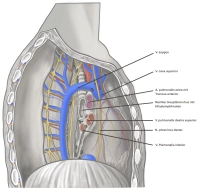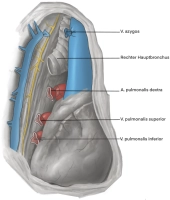A pneumonectomy involves a series of significant pathophysiological changes that are largely responsible for the high morbidity and mortality of the procedure.
Cardiac
After resection of the pulmonary artery, the deoxygenated blood from the right ventricle can consequently only be pumped unilaterally, which corresponds to a halving of the circulation. This leads to a 16-fold increase in resistance and thus to acute right heart strain. As a result, there is dilation of the right ventricle and increased oxygen demand by the myocardium. Likewise, the filling of the left ventricle is hindered by the right-sided dilation, which further worsens coronary circulation, potentially leading to acute irreversible right heart failure due to ischemia. In the long term, these effects can be compensated in a healthy lung by the buffering capacity of the pulmonary vessels and other mechanisms, so that permanent pulmonary hypertension usually does not occur.
Lung Parenchyma
Due to the loss of half of the gas exchange surface, a form of respiratory insufficiency is often present postoperatively. Here, preoperative diagnostics with assessment of functional operability and the lung function expected postoperatively are of enormous importance. However, despite good preoperative lung function, postoperative hypoventilation, mucus retention, pneumonia or ARDS, cardiac insufficiency, or sepsis can quickly lead to a life-threatening condition due to the lack of reserve. Even with good compensation and a healthy lung, long-term exertional dyspnea and limitation of physical capacity are to be expected.
Thoracic Cavity
Immediately postoperatively, the "empty" thoracic cavity on the operated side is filled with air. In the further course, a serothorax forms, followed by the onset of scar remodeling with the formation of a fibrothorax and shrinkage of the operated side. This shrinkage can lead to the displacement of the heart, large vessels, esophagus, and trachea.


